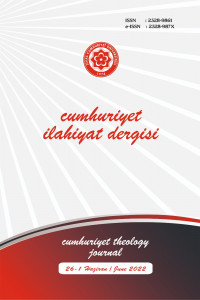Ortaöğretim Öğrencilerinin Din Kültürü ve Ahlak Bilgisi Öğretmeni ve Dersine Yönelik Metaforik Algılar
Metaphorical Perceptions of High School Students towards Religious Culture and Moral Knowledge Teacher and Lesson
Author(s): Hüseyin Kasım Koca, Mustafa MücahitSubject(s): Theology and Religion, Culture and social structure , School education
Published by: Cumhuriyet Üniversitesi İlahyat Fakültesi
Keywords: Religious Education; High School; Religious Culture and Moral Knowledge Course; Religious Culture and Moral Knowledge Teacher; Metaphor;
Summary/Abstract: Human emotions, thoughts and behaviors are determined by many complex processes. Through this process, it is possible to determine an attitude towards events and facts. At this point, metaphors provide an important data source in determining the attitudes of the individual and revealing the thoughts that affect the behaviors. It can be said that metaphors, which are a way of detecting the unknown based on the known, can play an important role in increasing the quality of education in this respect. In recent years, determining attitudes through metaphors has begun to be accepted as an important method in the field of education and many studies have been carried out on this subject. In this study, it is aimed to determine the perceptions of secondary school students towards the Religious Culture and Moral Knowledge course and its teachers through metaphors. In the study, which was designed in a phenomenological (factual) design, one of the qualitative research designs, the participants were determined by the criterion sampling method, one of the purposive sampling methods. Data were obtained from 262 students of 4 different secondary education institutions in the 2021-2022 academic year. Research data were collected by completing the sentences "Religious Culture and Moral Knowledge teacher...similar/because...and Religious Culture and Moral Knowledge lesson...similar/because..." in the form given to them. The metaphors reached at this stage were categorized according to their semantic content, completed, expressed numerically, tabulated and interpreted. Two field experts were consulted to determine the reliability of the study. Opinions received were evaluated using the formula developed by Miles and Huberman (reliability = consensus / (consensus + number of disagreements)) and the agreement between the data was calculated. Accordingly, the Miles and Huberman agreement coefficient, which shows the reliability of the research, was determined as 0.92. In the study, it was determined that the metaphorical perceptions of the students regarding the Religious Culture and Moral Knowledge course were grouped under three themes as positive, negative and ambiguous. In the research where it was determined that the majority of the students (82.44%) produced positive metaphors for the Religious Culture and Moral Knowledge teacher, it was determined that approximately one out of every 10 students (9.54%) produced ambiguous metaphors for the course. while the rest (8.02%) reported negative metaphors. Among the positively produced metaphors, the most frequently repeated metaphors are “Road” (10.68%), “Imam” (6.87%) and “Friend” (4.58%). It was determined that the most frequently repeated metaphors among the negatively produced metaphors were "Unnecessary" (1.14%), "Bully" (0.76) and "Boring" (0.76). Most of the metaphors produced by the students for the Religious Culture and Moral Knowledge course (81.3%) are positive, in the remaining part, it was determined that some of the students (4.58%) were not clear and the metaphors produced by the other part (14.12%) had a negative orientation. Among the metaphors produced positively for the Religious Culture and Moral Knowledge course, the most frequently repeated metaphors were “Life” (8.77%), “Book” (6.48%) and “Guide” (3.81%). The most repeated negatively produced metaphors were "Useless" (2.29%), "Boring" (2.29%) and "Empty" (1.14%). Of the 262 secondary school students who submitted data to the study, 111 of them produced metaphors for Religious Culture and Moral Knowledge teachers; 123 of them produced metaphors for the Religious Culture and Moral Knowledge course. Expressing the metaphors produced for the Religious Culture and Moral Knowledge teacher and his lesson with very different concepts issimilar to the studies in which metaphorical perceptions about different lessons are tried to be determined. As the reason for this situation, it can be stated that students experience very different interactions with the RCMK course and teachers at both primary, secondary and high school levels. In addition, it can be said that different perceptions of students towards religion they learned outside of school and the people who teach religion can also differentiate their attitudes towards the Religious Culture and Moral Knowledge course and the teacher. It should be emphasized that students produce negative metaphors both for the Religious Culture and Moral Knowledge teacher (8.02%) and for the Religious Culture and Moral Knowledge course (14.12%). The generation of negative metaphors for the Religious Culture and Moral Knowledge course is an important obstacle for these students to reach the targeted gains in the course. For this reason, it can be stated that revising the curriculum of the Religious Culture and Moral Knowledge course in which the curriculum is included and the methods and techniques used in the course can contribute to the achievement of the objectives of the Religious Culture and Moral Knowledge course. In addition, it can be said that these proposed studies can contribute to the students who use positive and neutral expressions about the Religious Culture and Moral Knowledge course to benefit more from this course.
Journal: Cumhuriyet İlahiyat Dergisi
- Issue Year: 26/2022
- Issue No: 1
- Page Range: 321-339
- Page Count: 20
- Language: Turkish

